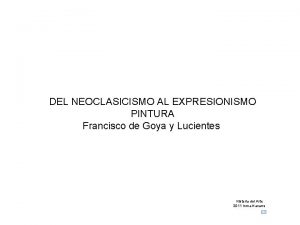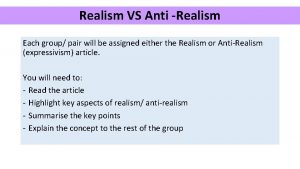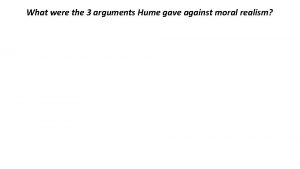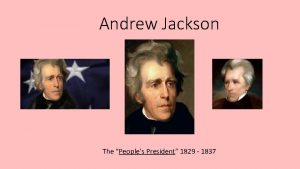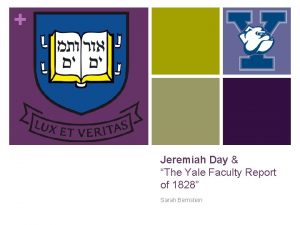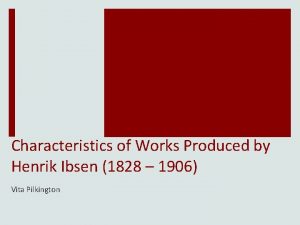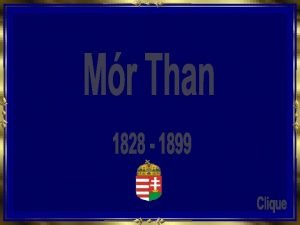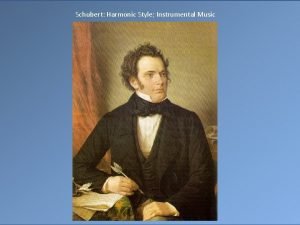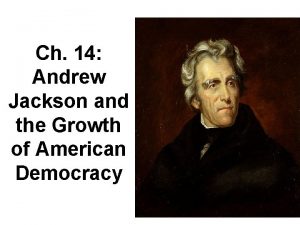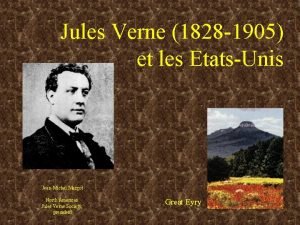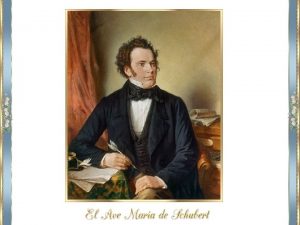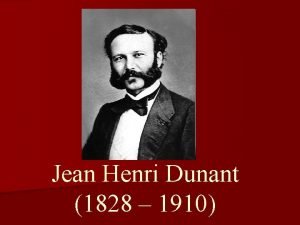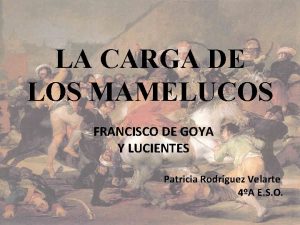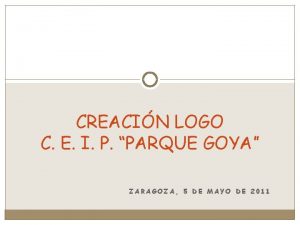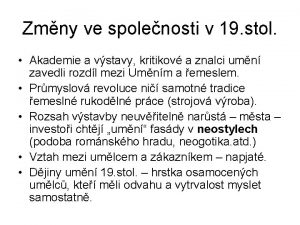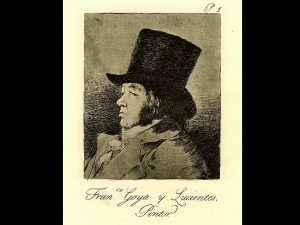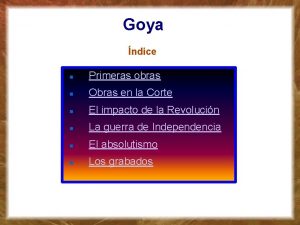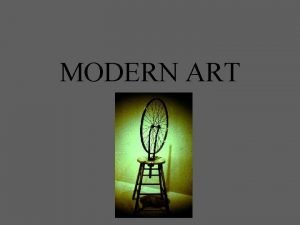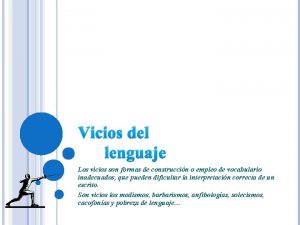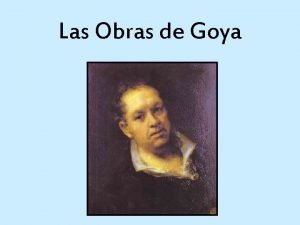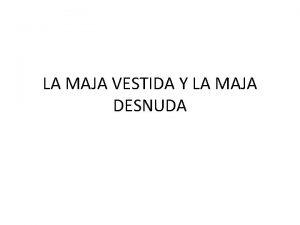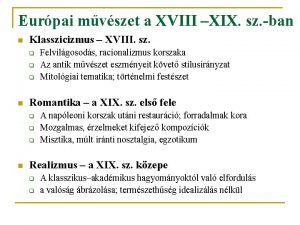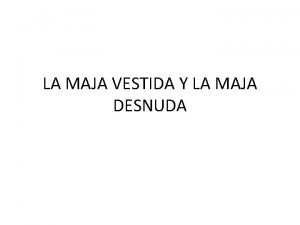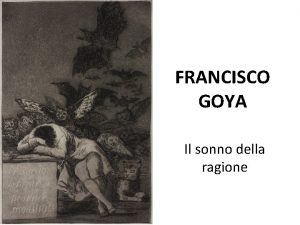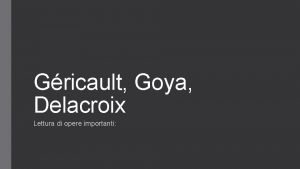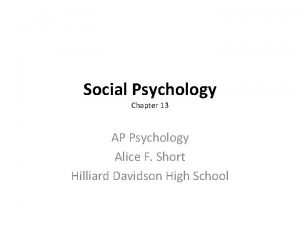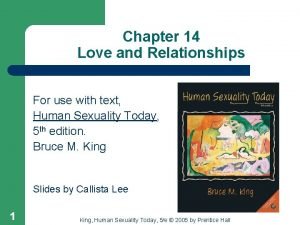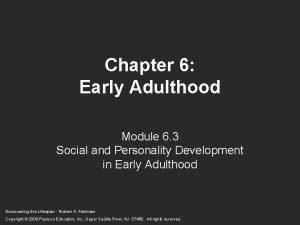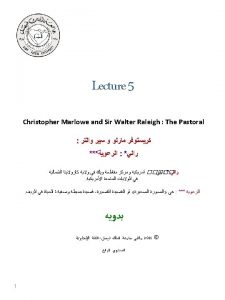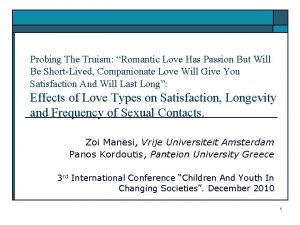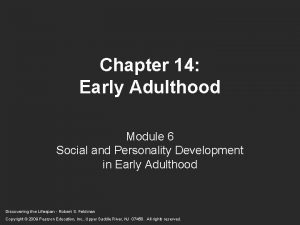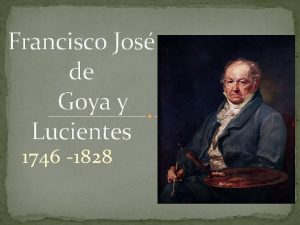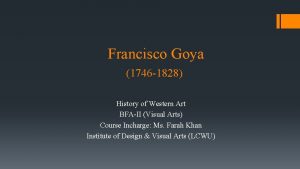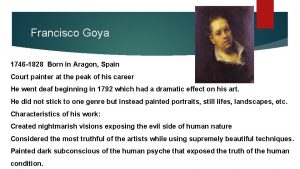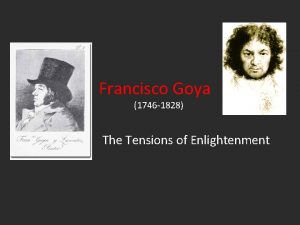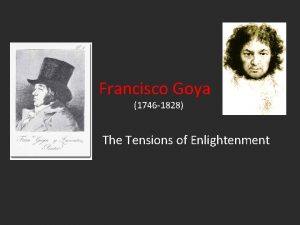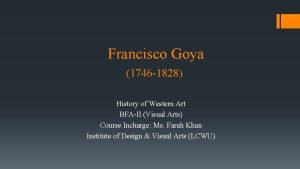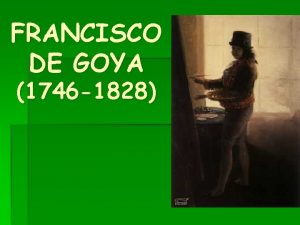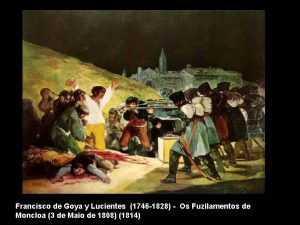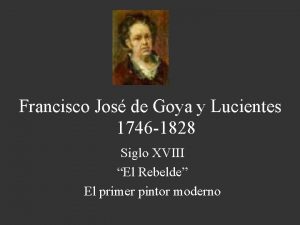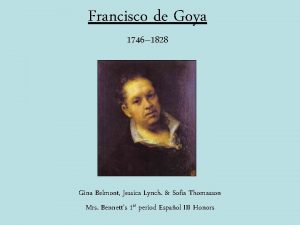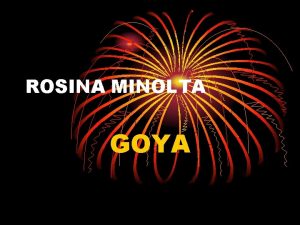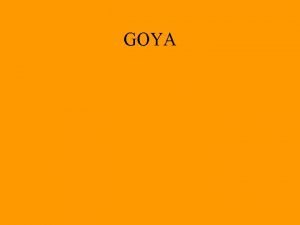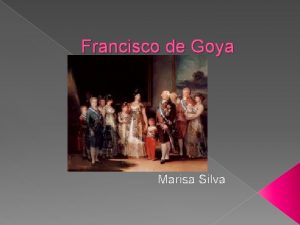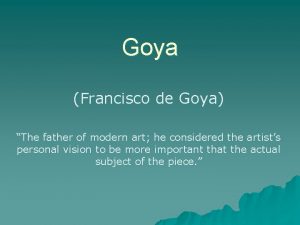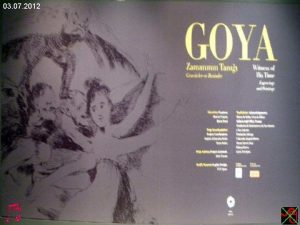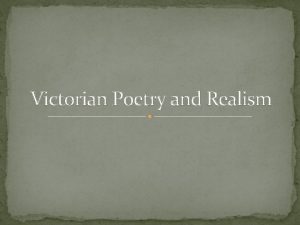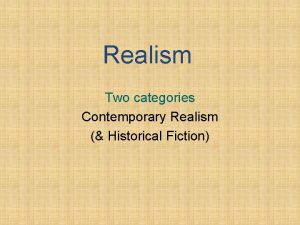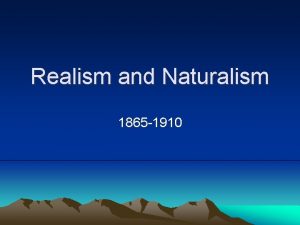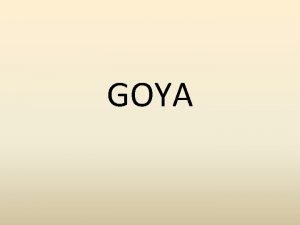Francisco de Goya 1746 1828 Passionate realism Francisco








































- Slides: 40

Francisco de Goya 1746 - 1828 Passionate realism. .

Francisco Goya • • • Born 1746 in Fuendetodos, Saragossa, Aragon, the son of humble parents - His father was a gilder and his mother owned and farmed a small piece of land. The landscape was parched and barren, and a far cry from the splendours of the Spanish Court. In 1760 the family moved to Saragossa and Goya took drawing and painting lessons from academic painter José Luzán. In 1763 he went to Madrid, attempting to gain entrance to the Academia of San Fernando. He was rejected, twice. At the time both Mengs (The vanguard of neoclassicism) and Tiepolo (the heir to the Barroque) represented the two opposing trends in Spanish Art at the time. Goya fitted ill with either camp. C. 1770, Goya went to Rome. 1 n 1771 he won 2 nd place in the competition for admission to the Accademia di Belle Arti of Parma (Notes suggest he would have won first prize if his work had been more conventional). 1773 He was in Madrid, where he married Josefa Bayeu, sister of the painter who had introduced him into Madrid Society. First important commission from Mengs, for a series of cartoons for tapestries for the Royal Tapestry Factory at Santa Barbara. Introduced him into Court circles, and permitted his ‘sketchy’ style free reign. 1

Francisco Goya • • King Charles III, probably the most liberal of Goya’s patrons, proposed a change of subject for nationalistic reasons. The Tapestries were to portray scenes of Spanish life. From 1776 -77 Goya’s work developed rapidly in confidence and maturity: Picnic on the Banks of the Manzanares, Dancing by the river Manzanares, The Sunshade, Fair in Madrid, The Crockery Seller, and others followed. Influenced by Houasse’s genre paintings and religious scenes and admired their spontaneity. After the death of Mengs, Goya took up la onely position in opposition to the dry academic work which predominated. Continued with tapestry cartoons of growing maturity. 1780 “Crucifixion” was accepted by the Academy - it clearly satisfied their taste for sentiment and clearly modelled figures. His gift for compassion is already evident in the treatment of Christ’s head. Expresses sincere moral feelings, and avoids academicism. 1777/8 - Discovered the works of Velasquez, and made a series of engravings after them 1780 -81 - Commission for the “Virgin, Queen of Martyrs” for Cathedral dome of El Pilar in Saragossa led to fierce struggle between his brother in law Francisco Bayeu (official director of the works and follower of Mengs), and Goya, who accepted theme, but insisted on painting in his own lively style. His painting for the Church of San Francisco el Grande in Madrid, “St Bernard preaching to Alphonso V of Aragon” (1784) was a triumphant success. Goya’s portrait commissions increased in the 1770 s, from Counts and clerics, and eventually from the Royal Family. He was appointed Assistant Director of painting at the Academy of San Fernando in 1785, and Official Painter to the Royal Family in 1786. He also won commissions from some of the greatest families in Spain: the Medinaceli, the Osuna and the Banco de San 2 Carlos.

The Quail Shoot, 1775, Prado, Madrid • Oil on canvas, 290 x 226 • The commission to design tapestries for royal palaces enabled Goya to move to the capital. It was not a highly regarded occupation. • The first series shows hunting scenes, conducive to the interests of the heir to the throne, Charles IV. • The action is arranged in two layers, front and back with the further figures slightly less defined. 3

The Sunshade, 1777, Prado, Madrid • Tapestry Cartoon, oil on canvas 104 x 152 cm. • Maria Luisa, Charles’s wife, wanted cheerful scenes fir the tapestries in her dining room. • Goya responded with this picture of an elegant young lady with her lapdog shaded by a green parasol held over her by her companion. • The costume reflects the latest French and Spanish fashions. 4

Winter, 1786 -87 Prado, Madrid • Oil on canvas, 275 x 293 cms, Tapestry cartoon. • From the middle of the 1780 s Goya no longer confined himself to portraying pleasurable subjects. He showed how harsh the winter can be for Spain’s peasants. • Perhaps trying to remind the central Court of the real conditions of its remote subjects. 5

The Straw Mannequin, 1791 -2 Prado, Madrid • • Oil on Canvas 267 x 160 cms; Tapestry cartoon. The artist’s eye grows ever more critical. Here, a light-hearted carnival tradition assumes a cruel dimension, in a scene which depicts what strong women can do with a weak man, who is tossed about helplessly at their pleasure. In earlier drawings, the mannequin’s head is upright, but this suggested it was enjoying the sensation of flying. In the final version, the head is twisted round, as if to emphasize the discomfort at its fate. 6

Don Manuel Osorio Manrique de Zúniga, 1788, New York, Metropolitan Museum • Oil on canvas 127 x 101 cms • Like Velasquez, Goya was also in demand as a painter of children. But behind the pretty young heir, two greedy cats are eyeing their victim. The boy seems unaware that his pet magpie is in danger. 1789 marked the French Revolution and the brutal end to the French aristocracy, including the King and Queen, many of whom were related to the Spanish aristocracy. Following the initial phase, Napoleon established a second monarchy, but the aftermath was turbulent and brought in years of turmoil • 7

The Family of Charles IV, 1800 -01, Madrid, Prado 8

The Family of Charles IV, Madrid, Prado • Oil on Canvas, 280 x 336 cm A vision of the Royal Family seen through the eyes of an ordinary citizen. Goya has certainly not flattered his models here. The royal clan are depicted as they are, some seem confused, some haughty, some a little crazy. They hold on to what they have, puzzled by the changing political climate, and unable to prevent the onward march of history. The last days of the fading Rococo, giving way to the harsher realism of citizen’s democracy. . The gap in age between the King and Queen is notable. She was 48 and had borne 10 or 12 children, yet she wears a cupids dart in her hair, in the latest French fashion. Rumours circulated by her rivals suggested that the boy between them was the son of Goday, his first minister and his wife’s lover. A painting in the background, of “Lot and his Daughters” suggests woman following their unbridled desires…Is this a coincidence? The artist poses himself in the background, no longer the humble servant, more the confident individual with his own world-view. 9

Francisco Goya • • • After a setback in 1788 when he failed to be appointed Director of the Academy through the rivalry and scheming of the members, Goya was appointed Court painter to Charles IV in 1789, which secured his position at the Court. From 1786, the relationship between Goya and the Alba family became increasingly close. His friendship with the Duchess belongs to a later date (1795 -97) In 1790 he was in Valencia, as Director of the Academy di San Carlo, then in Saragossa, and in 1792 in Cádiz, where he painted the portrait of Sebastián Martínez. Whilst there, he contracted the illness which left him deaf and had such a profound effect on his life. After his partial recovery Goya returned to Madrid, and emerged with a new-found mastery, and a greater introspection, an an all-pervading satirical intensity. “in order to occupy my mind, numbed by meditation on my own ills, and to repay the heavy expenses incurred during my illness, I have begun to paint a series of small pictures in which I have succeeded in including observations which cannot generally be found in commissioned works; as a rule in commissioned paintings, caprices and imagination cannot be developed. ” (1794) Paintings such as “Witches in the Air” (1798), and “The Burial of the Sardine”(1793) reflect this new personal style. In 1795 his brother-in-law Bayeu died, leaving the post of Director of the Academy free for Goya, and at this time his friendship with the Duchess of Alba intensified, and gave rise to scandal. 1798: important series of frescoes in San Antón de la Florida 10 1799 Los Caprichos - satirical etching series, showing the follies of the world.

“The Sleep of Reason Produces Monsters” (Capricho 34), 1797 -98 • Etching & aquatint, 21. 6 x 15. 2 cm • The etching of the sleeping artist, threatened by fantastical faces, was originally intended to open the ‘Caprichos’ cycle. • The ‘reason’ is also the world of logic and rationality which is ever threatened by breakdown, by madness of irrationality. The dangers unleashed by the French Revolution will sweep across Europe, changing all that was known before into something as yet uncertain. 11

Witches in the Air, 1797 -8 Prado, Madrid • Oil on Canvas, 43. 5 x 31. 5 cm • Commissioned by the Duchess of Osuna, along with five other such scenes, for her own pleasure. The Duchess was highly intelligent and educated, and probably enjoyed the frisson of terror these macabre scenes portray. Witches are sucking the blood out of somebody dead or dying. The man with the cloth over his head is making a sign to try and ward off evil spirits. • 12

Francisca Saba y Garcia, 1804 -8, National Gallery, Washington • • • Oil on Canvas, 71 x 58 cms The subject is about 20 years old and is profiting from the emancipation of women cautiously proceeding in Goya’s day. Her face is no longer concealed by a veil, and she looks out self-confidently at the viewer. Goya records the changing attitudes to women in contemporary Spain, following the expulsion of the Moors 300 years before, and increasing pressures from the Enlightenment. Goya depicts independent, sometimes duplicitous, career-oriented, successful women, not just passive subjects. The term in Spanish for this new found confidence is ‘marcialidad’ (militancy) 13

Francisco Goya • • In 1808 Goya was in Saragossa, observing and recording the disasters caused by war in his home town. The paintings were discovered by the French troops and destroyed Back in Madrid, he continued to work as Court Painter to King Joseph, and was entrusted with the task of selecting 50 Spanish works of art to be shipped to France. For this he was given‘The Order of Spain’ In 1812 his wife Josefa Bayeu died - Although she was married to Goya 39 years and bore him six children, of whom only one son Javier survived infancy, there are no clear portraits of her in Goya’s work. The two key paintings from 1814 - of the May Events - were commissioned in honour of the Spanish Resistance, They are landmarks in the history of Western painting. No painting can be further removed from traditional History Painting, yet they are more closely connected to the events they portray than any others. The return of Ferdinand VII brought with it the persecution of liberals, and Goya too was threatened, even though he continued to paint portraits of the King and his courtiers. In 1812 he returned to Religious painting with the “Assumption of the Virgin” for Chinchón Cathedral, “The last communion of St Joseph Calasanzio (1819) and the “Agony in the Garden” (1819), whose style and freedom of technique bring them to the brink of modernism. The “Caprichos” and “The Disasters of War” had both been inventive and free in technique. The “Tauromaquía” and the ‘”Proverbios” (c 1819) present extraordinarily original compositions. In 1819 Goya bought a country house on the banks of the Manzanares, known already as the ‘Quinta del Sordo’ (House of the deaf man). During and after recovery from another bout of illness in 182022 Goya began the decoration of the house with an extraordinary series of 14 paintings, “The Black 14 Paintings”. The subjects are freely brushed, on an enormous scale like giant sketches.

The Duchess of Alba, 1795 Collection of the Duchess of Alba, Madrid. • Oil on Canvas, 194 x 130 cm • Widowed in 1796, the Duchess of Alba became Goya’s companion until about 1800. He made several drawings of her, including paintings which depict her wearing a ring with Goya’s name on it, and pointing to the ground on which is written “Only Goya”. • She appears in several of the ‘Caprichos’ later, following their separation, by which Goya seems to have been badly affected. 15

‘Maja Desnuda’, 1797 -1800, Prado, Madrid • • Oil on Canvas, 97 x 190 cm The sitter gazes out coolly at the painter. Pictures of nudes were forbidden in Spain, and only Godoy the First Minister could dare to commission one for his collection. After his fall from power, The Inquisition invited Goya to appear before them to justify his ‘actions against public morals’. Rumours had it that the model was the Duchess of Alba, but this is pure legend, and the facial features are quite distinct. 16 The head sits rather awkwardly on the neck and shoulders, suggesting a later overpainting.

Maja clothed, 1800 -05, Prado, Madrid • • • Oil on Canvas, 95 x 190 cm Following the naked version, Godoy also commissioned a clothed ‘maja’probably to show his more orthodox guests. Godoy also owned Velasquez’ “Rokeby Venus’. 17

The Colossus, 1808 -12, Prado, Madrid • Oil on Canvas, 116 x 105 cm • Napoleon’s troops occupied Spain. The colosal figure rises above the Spanish landscape, before whom people and animals flee in panic. • The figure probably represents a personification of the horror and chaos of war, whether it be the Napoleonic invasion, the murderous guerilla war or a generalised metaphysical threat. 18

The Second of May 1808, (1814) Prado, Madrid 19

The Second of May 1808, (1814) Prado, Madrid • Oil on Canvas, 266 x 345 cms • On 2 May 1808 there was a skirmish in Madrid. A French soldier was pulled off his horse and almost lynched. • General Murat announced: “French blood has flowed. It demands vengeance. ” Mamelukes of the Imperial Guard are attacking furiously, and the Spanish are defending themselves with knives. It is not clear who is the victor. 20

The Third of May 1808 (1814), Prado, Madrid 21

The Third of May 1808 (1814), Prado, Madrid • • • Oil on Canvas, 266 x 345 cms On 3 May, some 400 Spaniards, arrested the day before, were executed by French firing squads. The massacre sparked off nationwide uprising. Goya’s dramatic picture sets a new standard for politically engaged painting. Painting not only records and depicts historical events, but is able, through its expression and technique, to dramatise and heighten the emotional impact of an event. It is the first truly modern ‘protest painting’ whose successors will include Picasso’s “Guernica” in the 20 th-century. 22

The Young Ones, 1812 -14, Lille, Palais des Beaux Arts • • Oil on Canvas, 181 x 122 cm In the earlier Tapestry cartoon with the Green Parasol, Goya depicts a fashionable lady with her maidservant and little dog. Here, a similar subject is depicted but with the addition of the common people, washerwomen, in the background. Goya is aware of the gap between rich and poor in contemporary Spain, and contrasts the two as a contradiction, side by side. The figures in the foreground are unaware of the women from the poorer classes labouring in the background. 23

‘The Old Ones’, 1810 -12, Lille, Palais des Beaux Arts • Oil on Canvas, 181 x 125 cm • • Chronos, the God of Time, spreads his wings behind the two old hags, who remain unaware. With their faces made up and dressed in their finery (one of them wears her hair with a love dart in it, just as Queen Maria Luis had done), the other’s skull is appearing through her ruined face. They are still asking the mirror, “Que tal? ” - how are you? (Who is the fairest? ). In both pictures, the aristocracy whether old or young, are depicted as out of touch with the ordinary people, and with the events which are going to 24 destroy their world forever.

Francisco Goya • 1799 - Goya was First Court Painter and began on the major series of Royal portraits including the “Portrait of Charles IV”(1799), and “The Family of Charles IV at Aranjuez” (1800) and for the next 10 years Royal portraits were the mainstay of his production. • Even as his official duties at Court and the Academy demanded his full attention, his painting developed an increasingly polemical and satirical direction. In 1808 Napoleon threatened invasion. In Aranjuez, the Spaniards, hoping for liberation from the French, revolted against the King and forced his abdication and the succession of Ferdinand VII. An inept monarch, he abandoned Madrid at the first attack, and let Murat enter the city unopposed. • • • On the 2 nd of May, the Madrid people took up arms and attacked a detachment of Mamelukes. On the Third of May, reprisals by the French were violent, and started a war which lasted four years, under the short-lived reign of Joseph Bonaparte. Many of Goya’s friends were Frenchified intellectuals and anti-absolutists; and hoped for liberty, and a Constitution under the French. • Goya retained his Court duties, and painted ‘Ferdinand VII on Horseback’. The depiction confirms that Royalty’s time had passed. The Disasters of War’ date from a little later (c 1808 -20). Here the subject, his treatment of it and the evident passion driving his hand, are entirely modern. • 25

The Disasters of War • ‘This is Worse” (plate 37) 1812 -15, Etching & wash, 15. 7 x 20. 7 cm • ‘What more can one do? ’ (Plate 33), 1812 -15, Etching & wash, 15. 8 x 20. 8 cm 26

The Burial of the Sardine, 1812 -19, Museo de la Real Academia de San Fernando, Madrid • Oil on panel, 82. 5 x 52 cm. • The carnival celebrations in Madrid culminated on Ash Wednesday in a procession with dancing and masks. A heathen spring festival and a parody of religious processions. Goya suggests demonic forces behind the masks and costumes, as if the forces of chaos were lurking just below the level of appearances. 27

Goya And his Doctor Arieta, 1820, Minnesota Institute of the Arts Minneapolis • Oil on Canvas, 117 x 79 cm • Goya suffered a serious illness in in 1820. After his recovery, he painted himself as a reluctant patient in the trusty hands of his doctor, Arieta, who is carefully, but forcefully administering some medicine to him. The painting is a personal record of their friendship. • Goya’s face is grey like his coat, and the doctor brings an element of red, echoed in the bedcover and his own face, to his complexion. 28

Duel with Cudgels, 1820 -23, Prado, Madrid • • • Oil on Canvas, 123 x 266 cm. Two men are battling with cudgels. Both are knee-deep in sand so that neither can get away and there is no certainty that even the winner will be able to extricate himself. There are no witnesses to the scene. 29 Pointless brutality in a barren landscape. The stupidity of humans, endlessly repeated. .

The Dog, 1820 -1823, Prado, Madrid • Oil on Canvas, 134 x 80 cm • The dog’s head occupies a tiny proportion of the whole canvas. The rest is devoid of objects. • Never before has an artist exercised such radical freedom, or such radical renunciation to express solitude. • A truly modern painting, which presages, as does the ‘Duel with Cudgels’, some of the existential work of Beckett, Giacometti and Francis Bacon in the 20 th-century. 30

Saturn Devouring his Children, 1820 -23, Prado, Madrid • • Oil on Canvas, 146 x 83 cm One of the Black Paintings from the ‘Quinta del Sordo’, intended for Goya’s dining room, perhaps as a ‘reminder’ like the skeleton painted on Michelangelo’s staircase which he would pass each day. Saturn, fearing that his own sons are going to destroy him, devours them first. Goya omits all reference to the Classical myth, and depicts the god as a humanoid monster feeding in a frenzy on a corpse. An image of startling brutality and horror. 31

The Procession of San Isidore, 1820 -23, Prado, Madrid • Oil on Canvas, 140 x 438 cm, Detail 32

The Procession of San Isidore, 1820 -23, Prado, Madrid • • Oil on Canvas, 140 x 438 cm, Detail One of the “Black Paintings” In his youth, Goya depicted the Feast of St Isidore as a colourful pageant, suitable for tapestry cartoons. Here it becomes a nightmare procession of crazed and ecstatic crowds, sweeping over the hillsides with an elemental energy. The brushstrokes are loose and violent. Faces are captured in a few wild brushstrokes. Colour has almost vanished in the darkness, with only the contorted faces and the white shirts catching the light Goya depicts the irrational hysteria of the crowd. 33

Nada!, The event will tell, 1812 -20, The Disasters of War (Plate 69) • Etching & aquatint, 15. 5 x 20 cm. 34

Unfortunate events in the Front seats at the Ring in Madrid, 1815 -16 • • Etching & aquatint, (Tauromaquia, Plate 21), 24. 5 x 35. 5 cm 35

Sketches: Old Man on a Swing; Phantom, Dancing with Castanets • • • (Album H), 1824 -28; Black Chalk, New York, Hispanic Society, 198 x 15. 1 cm. (Album H), 1824 -28; Black Chalk, Prado, Madrid 36

The Milkmaid of Bordeaux, 1825 -27 Prado, Madrid • Oil on Canvas, 74. 8 x 68 cms • One of his last works, painted during his final stay in Bordeaux. • Unusually, he returns to the softer blues and pastel tones of his earlier work. • The handling is freer, more airy and almost impressionistic, and the mood is tranquil and introspective. 37

Self Portrait, 1787 -1800 Goya Museum Castres • • • Oil on Canvas, 50 x 30 cm The last ‘Self Portrait’ In 1823 Goya gave over the ‘Quinta del Sordo’ to his nephew Mariano and in 1824 went into hiding, fearing reprisals from the restored monarchy. He fled to Bordeaux to stay with his old friend Moratín and remained in Paris a long time, then returned to Bordeaux with his companion Loecadia Weiss. The Court granted him permission to stay and, much freer, he painted his last works in a freer, almost impressionistic style. He died on 11 April 1828 in Bordeaux. 38

Still Life: A butcher’s counter, 1810 -12, Louvre, Paris • Oil on Canvas, 45 x 62 cm Conclusion • “Realism, not in its accepted sense of naturalistic representation, but as a form of the artist’s awareness of the function of his work, came into existence in the troubled Europe of the early 19 th-century. The realism of a Courbet or a Daumier was anticipated by nearly a century by the lonely figure of Goya, whose work was largely ignored or misunderstood. ” • (Abbruzzese, 1967) 39
 1747-bsn
1747-bsn Francisco de goya expresionismo
Francisco de goya expresionismo Realism vs anti realism
Realism vs anti realism No moral
No moral Normative ethics
Normative ethics 1828
1828 Yale report 1828
Yale report 1828 1910-1828
1910-1828 1828 1910
1828 1910 1910-1828
1910-1828 1910-1828
1910-1828 Melody of gretchen am spinnrade
Melody of gretchen am spinnrade Revolucion mexicana
Revolucion mexicana When was andrew jackson inaugurated
When was andrew jackson inaugurated 1905-1828
1905-1828 Compositor austriaco fallecido en 1828
Compositor austriaco fallecido en 1828 Jean henri dunant
Jean henri dunant Carga de los mamelucos
Carga de los mamelucos Ceip parque goya
Ceip parque goya Goya balkon
Goya balkon نيفيس الفاريز goya
نيفيس الفاريز goya Goya primeras obras
Goya primeras obras Goya hasta la muerte
Goya hasta la muerte Fransico goya
Fransico goya Il massacro in corea
Il massacro in corea Vi dos cuadros cuyos cuadros son de goya
Vi dos cuadros cuyos cuadros son de goya Primera etapa de goya
Primera etapa de goya Autor de la maja desnuda
Autor de la maja desnuda Goya boszorkányszombat
Goya boszorkányszombat Autor de la maja desnuda
Autor de la maja desnuda Goya chiaroscuro
Goya chiaroscuro Goya delacroix
Goya delacroix Passionate love definition ap psychology
Passionate love definition ap psychology Passionate love vs companionate love
Passionate love vs companionate love Passionate love vs companionate love
Passionate love vs companionate love Labeling theory of passionate love
Labeling theory of passionate love The passionate shepherd to his love analysis
The passionate shepherd to his love analysis Elizabethan english
Elizabethan english Passionate love vs companionate love
Passionate love vs companionate love Heightened language
Heightened language Labeling theory of passionate love
Labeling theory of passionate love

